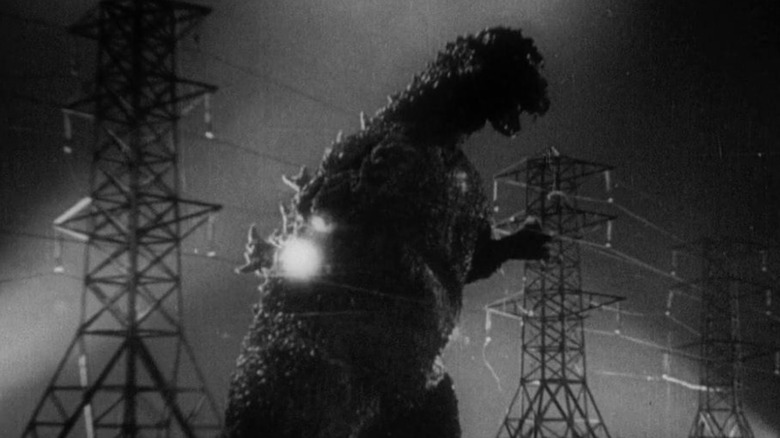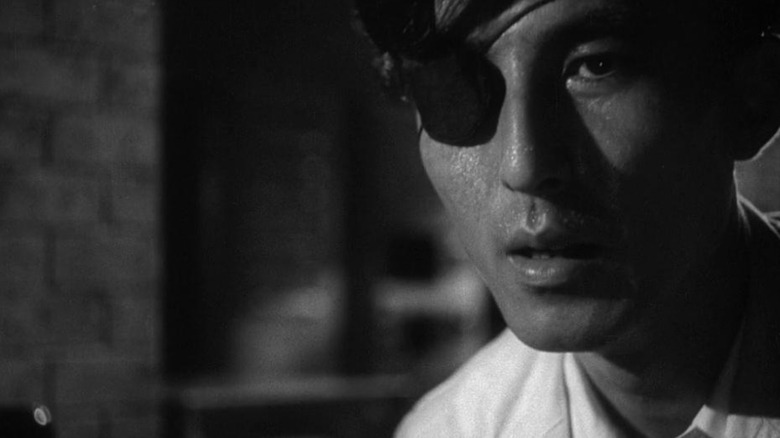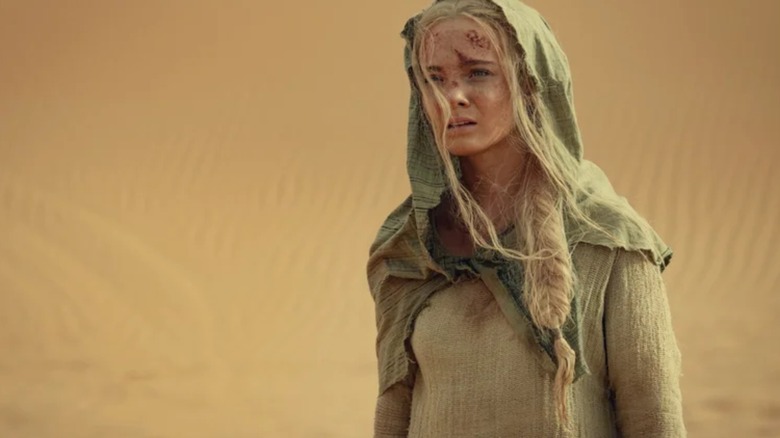Simply Getting To Godzilla's Set Had Actors Passing Out Right And Left
Everything about the making of 1954's "Godzilla" feels miraculous. The movie is a feat of filmmaking on every level, from its now aged yet still impressive practical effects to its bold nuclear threat story set in post-war Japan. The film utilized every trick in the book to bring its eponymous kaiju to life, from building a monster costume out of plastic and concrete to creating Godzilla's infamous roar by rubbing the loosened strings of a double bass.
The team behind the original "Godzilla" movie, which included director Ishirō Honda, special effects director Eiji Tsuburaya, and the team at Toho Studios, got creative with their moviemaking at every opportunity. Still, no amount of creative problem-solving could save the cast and crew from the forces of nature, which apparently conspired against the production during some especially sweltering days in Japan's Mie prefecture.
In the 2019 LIFE magazine special edition "LIFE: Godzilla," the late actor Takashi Shimura is quoted talking about his time on set. In August 1953, according to the magazine, the movie started shooting a portion of its scenes on a mountain near the fishing village Ijika. The mountain doubled as Odo Island, a fictional town that's thrown into turmoil when the mysterious monster known as Godzilla begins stomping around one day. Cast members apparently stayed in the city of Toba overnight and made the slog to the mountain during the day, even with humid temperatures that, at one point, reached 100 degrees.
The original Godzilla filmed in 100 degree weather
According to an interview with Shimura, who passed away in 1982, a combination of seasickness and heat exhaustion nearly KO-ed a good portion of the cast and crew during filming. "It takes an hour and a half from Toba every day," he explained. "A coast guard ship is transporting us, so the motion is not as bad as on a fishing ship, but still, by the time we reach Ijika, four or five actors or actresses are down because of the motion sickness and heat." It's an ironic problem given that, on screen, Godzilla uses a heat ray as his signature weapon. The stress didn't stop there, though. "Then from the port to the top of the mountain, a really steep hill, it takes another hour," Shimura explained.
At the actual filming location, the cast and crew discovered that they had no shade. "When we get to the top, there isn't a single bit of shade there. So when we get there, filming is not even a concern," Shimura once said (per LIFE). "We are most worried about how to prevent getting sick from the heat." The classic kaiju film is neither the first nor the last movie to film in extreme heat. But while modern productions like "The Witcher" and "Dune: Part Two" could utilize things like electrolyte intensive drinks and SPF-absorbing umbrellas and shade coverings, the technology needed to keep people safe in the heat likely just wasn't there for a production filming in the '50s. In fact, LIFE notes that director Honda ended up with blisters and burns from spending so much time in the blazing sun.
Heat stroke has always been a threat to movie and TV sets
While stories of ultra-hot sets can, in retrospect, seem like fun bits of movie trivia or proof of artists' commitment to their vision, they can also get pretty serious. The TV show version of "Snowpiercer" temporarily shut down in 2022 during an extreme heat wave that led to 14 people needing medical treatment, while Austin Butler said people passed out from heat on the "Dune: Part Two" set. The history of unsafe weather conditions on set even goes back to the early days of Hollywood: In the book "Three Bad Men: John Ford, John Wayne, Ward Bond," author Scott Allen Nollen shares an anecdote in which the legendary director Ford argued with RKO about heat safety on the set of the 1934 war film "The Lost Patrol." When the studio told Ford to cut lunch breaks from three hours to 30 minutes to keep the film on track, he refused, reportedly saying, "I'm not going to have a lot of sick people on my hands — sunstroke and everything else." (The producer who had pushed for the shortened breaks actually ended up going to the hospital himself for heat-related illness.)
Luckily, the crew of "Godzilla" made it out of shooting unscathed, and their hard work and toiling in the sun paid off. The movie kicked off what would become the longest-running film franchise of all time, with 38 movies and counting. Though the original crew that brought the monster to life didn't get the recognition they deserved at the time of the film's release, the franchise is finally earning its flowers: Toho released one of the best "Godzilla" movies ever a few months ago, Legendary's kaiju universe is going strong, and earlier this year, the "Godzilla" films even took home their first Oscar.


